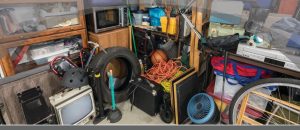Compulsive Hoarding: How to Know When Enough is Enough
 By: Jennifer B. Wilcox, PsyD
By: Jennifer B. Wilcox, PsyD
Staff Psychologist, OCD and Anxiety Disorders Program
What is compulsive hoarding?
Hoarding Disorder is a psychiatric illness and is considered to be a subtype of Obsessive-Compulsive and Related Disorders. The Diagnostic and Statistical Manual of Mental Disorders – 5th Edition (DSM-5) defines Hoarding Disorder (HD) as:
Persistent difficulty discarding or parting with possessions, regardless of their actual value. This difficulty is due to a perceived need to save the items and to the distress associated with discarding them.
The difficulty of discarding possessions results in the accumulation of possessions that congest and clutter active living areas and substantially compromises their intended use.
The hoarding causes clinically significant distress or impairment in social, occupational, or other important areas of functioning (including maintaining a safe environment for self and others).
The hoarding is not attributable to another medical condition and is not better explained by another mental disorder.
How is compulsive hoarding different from normal clutter or collections?
It is not uncommon for people to acquire a few extra possessions from time to time, resulting in occasional clutter. However, while normal clutter or collecting doesn’t usually interfere with a person’s daily functioning, compulsive hoarding often does. Compulsive hoarding also differs from normal clutter or collecting as it tends to become unmanageable, overwhelming, and causes significant distress or family discord. Though collections usually bring people joy and fill them with pride, hoarding often comes with shame and embarrassment.
Why do people hoard things?
Compulsive hoarding is thought to result from a combination of factors including genetics, environmental factors, life experiences, and learned behaviors. The reason one person hoards may not be the same as the reason someone else hoards. Some people who hoard are compulsive shoppers and acquire more things than they need or have room to accommodate. Others may have difficulty categorizing or making decisions about what to do with particular items. Sometimes they can’t remember what they own or where it is, leading to the purchase of duplicate items. Other times people hold on to possessions for emotional or sentimental reasons or get anxious when they discard things. Some people believe that the hoarded items may be useful someday and keep the items despite not needing them currently. The level of insight a person has about their struggles in these areas can vary widely from completely absent insight to good insight.
What types of things do people hoard?
The types of items a person hoards vary based on factors such as the reason they are hoarding and how severe their hoarding issues have become. Some commonly hoarded items include books, newspapers, magazines, boxes, bottles, clothes, food, items purchased in bulk, collectibles or vintage items, furniture, animals, or digital media.
How many people suffer from Hoarding Disorder and who does it affect?
While the exact prevalence of people who suffer from Hoarding Disorder is not certain, it is estimated that it affects approximately 2.5% of the general population. Studies have shown that prevalence rates in men and women are nearly equal and appear to be consistent across developed countries. Most studies report onset between 15 and 19 years of age and show a chronic course over the lifespan.
What is the treatment for Hoarding Disorder?
Hoarding Disorder is treated using Cognitive-Behavioral Therapy (CBT), a type of therapy that allows someone to work with a therapist to shift their thinking patterns and change their behavioral patterns to healthier ones. Randomized controlled trials have shown this to be an effective treatment for hoarding. While the data on the efficacy of medication for Hoarding Disorder is limited, there is some evidence to support the use of medication in the treatment of this disorder. For those hoarders who have limited insight, a Motivational Interviewing (MI) approach can help to foster their motivation and confidence. Finally, working on skills that improve the hoarder’s ability to maintain attention and focus, categorize items, and decision-making can be beneficial in treating Hoarding Disorder.
What can I do to help a loved one who seems to have issues with compulsive hoarding?
It is generally not recommended for family and friends to discard hoarded items without the hoarder’s permission. This can be extremely distressing for a compulsive hoarder and tends to make them upset, anxious, or angry. Instead, it is recommended that friends and family talk to their loved ones about their concerns and help them to seek professional treatment. Additional resources are available at the International Obsessive-Compulsive Disorder Foundation (IOCDF) and the Anxiety and Depression Association of America (ADAA).
Resources:
American Psychiatric Association, 2013. Diagnostic and Statistical Manual of Mental Disorders, 5th Edition. American Psychiatric Association Publishing, Arlington, VA.
https://instituteofliving.org/programs-services/anxiety-disorders-center/what-we-treat-at-the-adc/compulsive-hoarding
https://www.psychiatry.org/patients-families/hoarding-disorder/what-is-hoarding-disorder
Postlethwaite, A., Kellett, S., Mataix-Cols, D., 2019. Prevalence of Hoarding Disorder: A systematic review and meta-analysis. Journal of Affective Disorders 256, 309-316.
